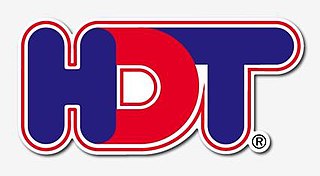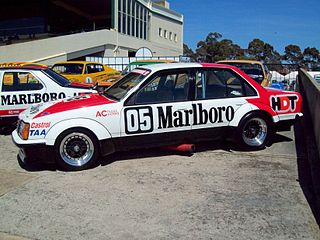
The Holden Dealer Team (HDT) was Holden's semi-official racing team from 1969 until 1986, primarily contesting Australian Touring Car events but also rallying, rallycross and Sports Sedan races during the 1970s. From 1980 the Holden Dealer Team, by then under the ownership of Peter Brock, diversified into producing modified road-going Commodores and other Holden cars for selected dealers via HDT Special Vehicles.
Allan George MoffatOBE is a Canadian-Australian racing driver known for his four championships in the Australian Touring Car Championship, six wins in the Sandown 500 and his four wins in the Bathurst 500/1000. Moffat was inducted into the V8 Supercars Hall of Fame in 1999.
Gregory John "Gregg" Hansford was an Australian professional motorcycle and touring car racer. He competed in the FIM Grand Prix motorcycle racing world championships from 1978 to 1981 and in Australian touring car championships from 1982 to 1994. Hansford was a two-time vice-champion in the 250cc road racing world championships. With 10 Grand Prix victories to his credit, he is ranked fourth for the most Grand Prix wins by an Australian behind Mick Doohan, Casey Stoner (38) and Wayne Gardner (18).

The 1983 James Hardie 1000 was a motor race for Group C Touring Cars contested at the Mount Panorama Circuit, Bathurst, New South Wales, Australia on 2 October 1983. It was the 24th "Bathurst 1000" and the third to carry the James Hardie 1000 name. The race, which took place as part of Round 4 of the 1983 Australian Endurance Championship, was contested over 163 laps of the 6.172 km circuit, a total distance of 1006.036 km.
Robert Morris is an Australian former racing driver. Morris was one of the leading touring car drivers during the 1970s and continued racing until 1984. Morris won Australia's premier Touring car race, the Bathurst 1000 in 1976. He also won the Australian Touring Car Championship in 1979. Morris was inducted into the V8 Supercars Hall of Fame in 2004.
The 1983 Castrol 400 was an endurance race for Group C Touring Cars held at the Sandown Park circuit in Victoria, Australia on 11 September 1983. The race was staged over 129 laps of the 3.1 km circuit, totalling 399.9 km. It was Round 3 of the 1983 Australian Endurance Championship and Round 3 of the 1983 Australian Endurance Championship of Makes.

The 1984 James Hardie 1000 was the 25th running of the Bathurst 1000 touring car race. It was held on 30 September 1984 at the Mount Panorama Circuit just outside Bathurst in New South Wales, Australia and was Round 4 of the 1984 Australian Endurance Championship. This race was celebrated as 'The Last of the Big Bangers', in reference to the Group C touring cars, which were competing at Bathurst for the last time.

The 1979 Hardie-Ferodo 1000 was the 20th running of the Bathurst 1000 touring car race. It was held on 30 September 1979, at the Mount Panorama Circuit just outside Bathurst. The race was open to cars eligible to the locally developed CAMS Group C touring car regulations with four engine capacity based classes.
John Francis Harvey was an Australian racing driver. He was a top Speedcar driver for many years in the 1950s and 1960s, winning many championship races including the NSW Championship for three successive years and the Victorian Championship twice before turning his skills to road racing where he had a long and successful career until his retirement at the end of 1988. In 1987 John made history driving the General Motors Sunraycer to victory in the inaugural World Solar Challenge from Darwin to Adelaide, the first international race for purely solar powered cars.
David John "Skippy" Parsons, is a retired Australian racing driver, who, while never a full-time racing driver, drove for some of the leading racing teams in Australia including the Holden Dealer Team, Perkins Engineering, Glenn Seton Racing and Gibson Motorsport.
Graeme Alfred Bailey, is an Australian retired racing driver, best known as co-winner of the 1986 Bathurst 1000.
The 1984 Australian Touring Car Championship was a CAMS sanctioned Australian motor racing title for Group C Touring Cars. It was the 25th running of the Australian Touring Car Championship, and the last to be contested by Group C cars as new regulations, based on international Group A, were introduced for 1985. The championship, which began on 18 February 1984 at Sandown Raceway and ended on 1 July at Adelaide International Raceway after seven rounds, was won by Dick Johnson driving a Ford XE Falcon.
George Fury is a retired Australian rally and racing car driver. For the majority of his career Fury was associated with Nissan, twice winning the Australian Rally Championship, and twice runner up in the Australian Touring Car Championship. Fury, a farmer living and working in the New South Wales country town of Talmalmo, was nicknamed "Farmer George" or "The Talmalmo Farmer".
The 1982 Australian Touring Car Championship was a CAMS sanctioned Australian motor racing title open to Group C Touring Cars. It began on 18 February 1982 at Sandown Raceway and ended on 16 May at Oran Park Raceway after eight rounds. The title, which was the 23rd Australian Touring Car Championship, was won by defending champion Dick Johnson, driving a Ford XD Falcon.

The 1983 Australian Touring Car Championship was a CAMS sanctioned motor racing title for drivers of Group C Touring Cars. The title, which was the 24th Australian Touring Car Championship, was contested over a series which began on 6 February 1983 at Calder Park Raceway and ended on 19 June at Lakeside International Raceway after eight rounds.

The 1980 Australian Touring Car Championship was an Australian motor racing competition for Group C Touring Cars. Authorised by the Confederation of Australian Motor Sport as a National Title, it was the 21st Australian Touring Car Championship.

The 1984 Castrol 500 was an endurance motor race staged at the Sandown Park circuit in Victoria, Australia on 9 September 1984. The event was open to Group C Touring Cars, competing in two engine capacity classes, Up to 3000cc and Over 3000cc. It also included a class for Group A cars which were to replace Group C cars in Australian Touring Car racing in 1985. The race, which was held over a distance of 503 km, was Round 3 of the 1984 Australian Endurance Championship.
The 1983 Australian Endurance Championship was a CAMS sanctioned motor racing title for drivers of Group C Touring Cars. The championship was contested over a six round series with all rounds run concurrently with those of the 1983 Australian Endurance Championship of Makes.
JPS Team BMW is a former Australian motor racing team that ran from 1981–1987. The team's main focus was touring car racing but also ran in sports sedans and GT cars as well. The team, under the management of former British Touring Car Champion and Formula One racer Frank Gardner, was based in Sydney and completed almost all of their testing at the old Amaroo Park circuit with Gardner himself doing most of the test miles in the various BMW's the team raced.
Allan Moffat Racing was an Australian motor racing team owned by multiple-championship winning Canadian-Australian racing driver Allan Moffat. The team was highly successful, winning races on three continents including three Australian Touring Car Championships in 1976, 1977 and 1983, four Bathurst 500/1000s including a memorable 1–2 victory in 1977, and the 1987 Monza 500, which was the inaugural race of the World Touring Car Championship.




